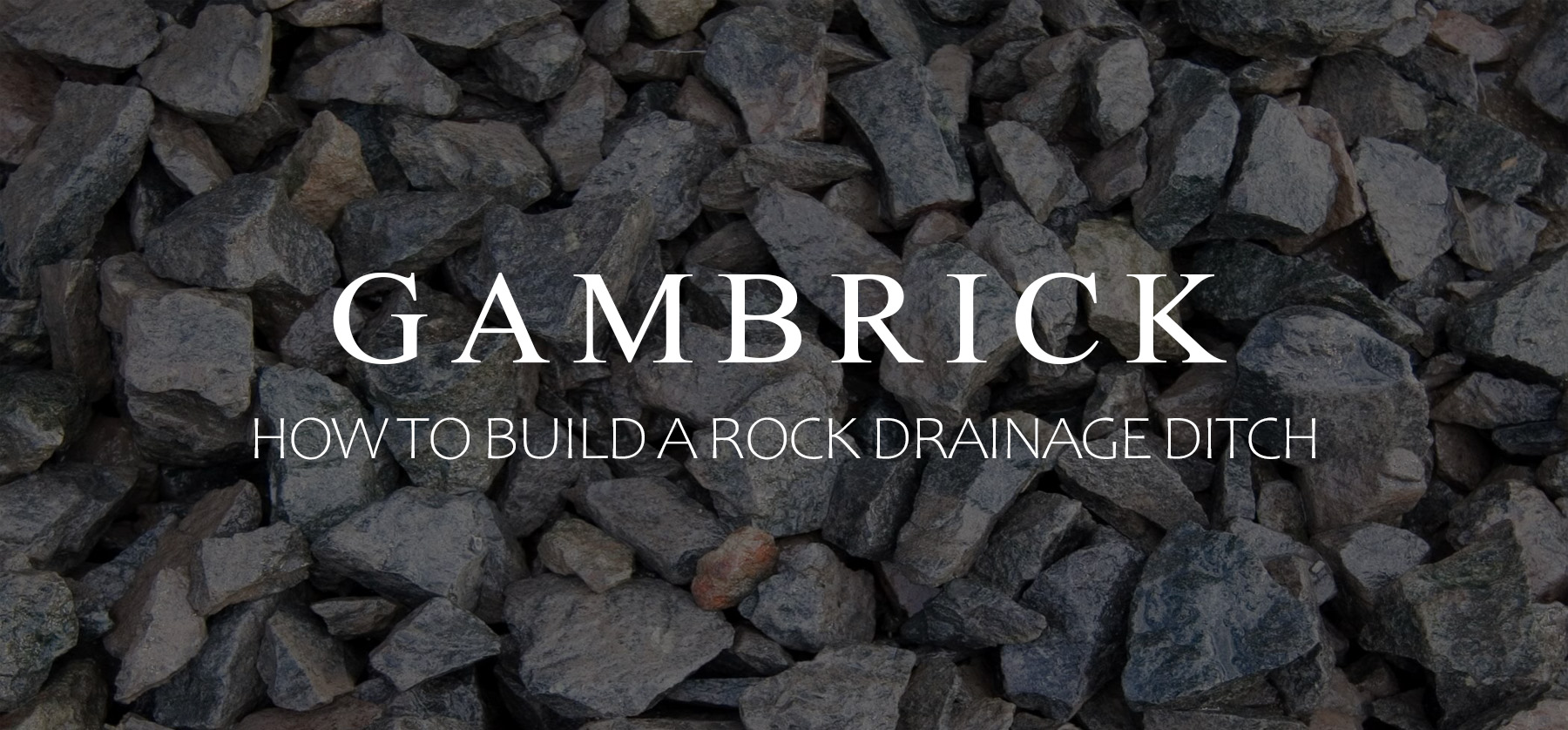How To Build A Rock Drainage Ditch
The primary purpose of a rock lined drainage ditch is to carry water from one place to another. Rocks help control the flow of water, trap sediment and reduce erosion. Most ditches function as part of a water mitigation plan but they can also be built just for looks. To dig a rock drainage ditch that’s functional, it’s important to understand how water flows on a property. The ditch should capture water and divert it to a new location where it can be safely drained. This is typically done to carry water away from a home or to prevent flooding. The best way to dig a rock drainage ditch depends on the amount of water you’ll be diverting, the type and size of the rocks you’re using and the size of the ditch.
To build a basic rock drainage ditch, dig a trench approximately 18 to 24 inches deep and about 36 inches wide. The length of the trench will vary based on where you need the water to go. Make sure the ditch pitches downhill at least 1%, which is 1/8 inch per linear foot of trench. This is the minimum slope you need for water to drain.
Line the trench with landscape fabric. Cover the fabric with 8 to 12 inches of gravel. Then top the gravel with rocks or smooth stones that are more decorative. Finally, add a border of stones along the edges. Make sure the stones all have a common coloring so the color scheme looks cohesive.
Finally, add some plants along the drainage ditch to create a dry creek bed look.
A well designed and built rock drainage ditch can be both functional and aesthetically pleasing which improves the property value of a home.
Building A Rock Drainage Ditch
Building a rock drainage trench is a simple and effective way to collect and channel water where you want it to go. When you’re building a house or developing a commercial site, you need a plan to deal with water. This is especially important when the grade naturally slopes at a home or other structure.
Building a rock drainage ditch is a very effective way to deal with excess water.
A rock drainage trench can be a uniform straight line of rock leading downhill into a drain. Or you can build it with twists and wider areas to create a more natural appearance. Include large boulders, trees, bushes, flowers and other landscaping elements to complete the look.
The purpose of a rock drainage ditch is to channel water from one place to another. As water runs downhill, it collects in the ditch and funnels where you want it. In large rural areas, this could simply be downhill and away from a house. But in tightly packed suburban areas a drainage trench usually runs into a larger drainage system or sewer.
Building a drainage ditch is fairly easy and can be done all by yourself with basic hand tools. But machines make the job easier and allow you to use much larger stones.
In the next section we’ll explain step by step how to build a rock drainage ditch:
The Tools Needed To Build A Rock Drainage Trench
Building a rock drainage ditch is a fairly simple job that requires excavation tools. It’s a lot of work if you dig it by hand, but using the right tools makes it easier. There are a wide variety of digging tools on the market, and each works in a slightly different way. These include a variety of shovels, a hoe, a pickaxe mattock and a demo bar.
When I dig a trench I bring a variety of tools because you never know what you’ll find once you start digging.
You’ll also need marking tools like paint or stakes and string, a tape measure and a long level to check the trenches pitch. If the trench doesn’t run downhill the water won’t drain properly.
Tools
- Marking Paint: Spray paint the edges of the drainage trench path.
- Stakes & String: Stakes & string can mark the trench path if you don’t have paint.
- Trenching Shovel: A long and slim pointed shovel used to dig trenches.
- Pointed Shovel: A standard pointed shovel used to dig dirt. They remove more dirt per shovel full than a trenching shovel.
- Flat Head Shovel: Use it to shape the sides and bottom of the trench.
- Pickaxe Mattock: The pick side is great for breaking up hard ground or prying up rock. The mattock side is for cutting through tough roots.
- Hoe: Use it to gather and move loose dirt. You can also chop down into the trench and pull dirt out. This is an easy way to dig a shallow trench.
- Measuring Tape: Used to mark the size of the trench and check the depth.
- Level: An essential tool because a drainage trench needs to be pitched.
- 60 Inch Bar: I always bring a 60″ bar with me when digging trenches to pry or break up really hard rock.
- Wheel Barrow: Use it to haul dirt, stones and the tools.
- Hand Tamper: Used to compact soil.
- Gloves: Digging a trench by hand without gloves will quickly cause blisters for most people.
- Tarp: Keep a tarp handy to cover the trench if it rains or else you’ll be digging in a mud pit.
- Boots: Work boots are not essential but I recommend wearing them.
- Laser Transom: A great way to check the depth and pitch of large trenches.
Planning A Rock Drainage Ditch
It’s very important to plan out your drainage ditch based on the slope of the land. Study the topography of the area and determine how water naturally flows. Then decide where you want the water to go and design the ditch accordingly.
An effective rock drainage ditch catches water as it flows downhill and diverts it to a new location. Water should enter somewhere on the side or top of the ditch and exit at the end of the ditch.
Most drainage ditches are positioned across a downward slope that’s directing water at a structure. The ditch collects and re-routes water through the ditch and to a new location which protects the structure from flooding.
A topographic survey of a property is very helpful when planning a ditch. It will show the elevation and slope of the entire property so you can position your ditch in the best possible location.
- Build your rock drainage trench where it will catch water flowing downhill towards a structure.
- Rock trenches can also drain areas of standing water.
- A rock drainage trench should slope about 1/8inch per foot which is a 1 degree slope.
- Curves can be used to catch more water and make the trench look natural.
- Have a plan for where the water exits the ditch.
In addition to planning the rock drainage ditch you also need one for where the water exits. A ditch channels water downhill to a single exit point which can funnel a lot of water in a rain storm. You could potentially cause another issue if you send too much water to the wrong place.
We’ll discuss where to send all that water in the next section:
Where To Drain A Drainage Ditch
When you build a rock drainage ditch, water running downhill enters the side or top of the ditch and funnels down to the bottom. If the ditch is large or there’s a heavy rainfall, this could be a large amount of water. You need a plan for what to do with all that water.
The best way to deal with all that water is by diverting it into a storm sewer system. They’re designed to carry large volumes of water to a central location like a lake, bay, river or reservoir.
Try not to dump the water where it will pool. You could end up creating large areas of stagnant pooled water which creates additional problems.
The water can be funneled to a large underground water collection tank called a cistern. The water can then be filtered and used as drinking or irrigation water.
- In a suburban area, a rock drainage ditch generally diverts water into a sewer or drainage system.
- If the property is rural, try to divert water to areas where it will continue to run downhill and absorb into the soil.
- Consider channeling the water into a cistern and filtering it for future use.
- Don’t let water funneled by the trench pool into standing water.
When planning your rock drainage ditch, try not to divert water into an area that can cause future problems.
Excavate The Rock Drainage Trench
To build a basic rock drainage ditch, dig a trench that’s at least 18 inches deep by 36 inches wide. This is enough rock to control the flow of water, prevent erosion and collect sediment. Mark the trench path with some paint or string and then start digging. Break ground with either a trenching shovel or use a pickaxe if the soil is really hard. Then excavate with either a trenching or pointed shovel.
A trenching shovel is better at slicing through roots and hard soil but the pointed shovel moves dirt faster. I usually break ground with the trenching shovel, then switch to the pointed shovel for digging the middle of the trench.
- Use a trenching or pointed shovel to do most of the work.
- A hoe is another great tool for breaking ground, chipping out dirt or shaping the trench.
- When digging out the flat bottom of a drainage trench, I use a flat head shovel.
- If you encounter roots or large rocks, pry them loose with the pickaxe or 60″ bar.
- Check the depth and width of your trench with a tape measure.
- Check pitch with a level.
- A drainage trench should be sloped at least 1/8 inch per foot which is a 1 degree pitch.
- Dig your drainage ditch at least 18 inches deep by 36 inches wide.
- If you want the trench to look more natural create curves and wider sections.
- The sides of a trench can be gently sloped or steep. A slope is a more natural look.
- If you want steep sides, use large rocks or small boulders that won’t erode.
The most important thing to remember when excavating a drainage ditch is pitch. If the trench isn’t pitched properly the water won’t flow where you want it.
How To Lay Landscape Fabric
Once the drainage ditch is dug out and checked for the proper pitch, line it with thick landscape fabric. I recommend using a water-permeable fabric which is not 100% waterproof. A water-permeable fabric has some holes so it can breathe a little bit. This helps the ditch dry out after the water is gone.
Landscape fabric helps with erosion and prevents weeds from growing up through the rocks. Don’t skimp on the fabric. I usually lay two layers just to be safe. The last thing you want are weeds growing out of the trench.
Landscape fabric also helps contain the smaller gravel you’ll be pouring on the bottom of the trench in a later step. It prevents the gravel from being mixed with dirt.
Fabric repels water that enters the ditch which helps it run downhill. Without the fabric, water would mix with dirt and create mud which would eventually erode the ditch.
- Line the bottom and sides of your rock drainage ditch with water-permeable landscape fabric.
- I usually use two layers of fabric.
- Extend the landscape fabric about 2 feet past the sides and ends of the ditch. You can trim or fold these end back later once you start lining the trench with stones.
- Smooth out the fabric as best you can so as not to leave bubbles.
- When laying fabric, start at the bottom of the trench and work uphill. Overlap the higher fabric on top of the lower fabric. This prevents water from running under the fabric.
- Overlap fabric at least a foot.
Using too much landscape fabric is better than too little. If you built the trench out of nothing but rocks, it would eventually erode and start to grow weeds. An all rock drainage ditch would need to be much deeper with larger rocks to prevent erosion and stop weeds.
How To Spread Gravel
A rock drainage ditch is built using different sized rocks. The smallest rocks, called gravel, are poured first and lay on the bottom. This is very similar to how natural rock streams function. Once your excavation is done and the landscaping fabric is in place, start spreading the gravel. Use a wheel barrow to pour gravel onto the fabric. Then spread it around with a hoe, shovel, stiff broom or rake.
When you spread the gravel, be very careful not to puncture the fabric. If you tear the fabric, remove the stones and install a new layer of fabric.
Spread between 6 to 8 inches of gravel over all the fabric. This creates the base or floor of your rock drainage ditch.
The best stone to use as a base for your rock drainage ditch is 3/4 inch gravel.But if you want a slightly larger rock use #3 crushed stone which is 3/4 to 2 inch.
Pro Tip: Cut a stick about 2 feet long or use a rod. Make a mark at 6 or 8 inches with marker or paint. Use the rod as a measuring stick to check the depth of your tone as you go. This method works better than using a measuring tape because it’s stiff and won’t bend.
- Spread 6 to 8 inches of gravel on the bottom of your drainage trench on top of the landscaping fabric.
- Make sure not to tear the fabric.
- If you puncture the fabric, add a new piece to cover the tear.
- The standard gravel for a rock drainage ditch is 3/4 inch.
- If you want a larger stone use #3 crushed stone which is 3/4 to 2 inch.
- Use a stick to check the depth of your gravel.
- Check to make sure the gravel layer is level.
Don’t use really small stone like pea gravel. They can be easily moved and compacted which prevents the flow of water. Larger rocks are more stable and allow the water to freely flow and drain properly.
Compact The Gravel
Once the gravel layer is spread on top of your landscape fabric, compact it with a vibratory or hand compactor. Compacting gravel helps hold it in place which resists erosion. It also helps establish the height of the ditch. 3/4 Inch gravel will generally compact about 1/2 to 1 inch which is important to consider if you’re trying to hit a particular higher mark.
Once compacted, take a height measurement, you may have to rake out a little or add some more stone to make your height.
- If you have to remove gravel, do it slowly with a rake.
- If you have to add gravel, add is slowly, spread it out evenly, compact and measure again.
- When you dig a rock drainage ditch, don’t forget to consider the final height. It has to be below grade after all the stone is installed or water won’t flow into and through it.
Gravel will naturally compact over time but it’s better to do it yourself. By compacting the gravel, you can control the final height of the ditch, keep the rocks in place and prevent them from moving when you work on the top layers.
Spread Larger Stones Or River Rocks
Once the gravel is spread evenly and checked for level, start spreading the top coat of larger stones. I like to use a stone that’s at least double the size of the gravel. The standard size gravel used to build a rock drainage ditch is 3/4 inch, so I use a 1 1/2 to 2 inch stone on top. But if you used a larger #3 crushed stone as gravel, which is 3/4 to 2 inch, use a 1 1/2 to 4 inch top stone.
Pour an addition 2 to 8 inches of stone on top of the gravel. Try to hide as much of the gravel layer as you can with the top stones.
Using different size rocks in layers helps water flow freely and prevents erosion. It also looks a lot better when the ditch is dry.
- Spread another 2 to 8 inches of larger stone on top of your gravel layer.
- Use a top stone that’s about 2x the size of your gravel.
- The top rocks will be seen so choose an attractive stone.
- Smooth stones create the appearance of a natural dry river bed.
Medium-sized rocks are the best size for a top layer. They promote good drainage, look great and add weight which keeps the gravel in place.
Don’t use sand or small rocks that can compact and clog up the water-flow.
Check to make sure the top stone are still level. But being level isn’t as important as the fabric and gravel since water will freely run around them. If a few big stones stand tall above level it’s OK and is actually a more natural look.
Add Large Stones Or Boulders
The final step in building a rock drainage ditch is adding large rocks or boulders. Stones are added on top of the fabric in stages according to their size. Gravel is first, followed by medium stones and then large rocks or boulders.
Large rocks or boulders are generally installed around the drainage ditch to create a border. I love the look of one or two large boulders surrounding a rock ditch. It looks more natural and adds weight to the ditch.
One or two large stones can also be installed inside the ditch if it’s wide enough. This adds to the natural appearance of the ditch.
Add Plants Around The Ditch
To finish the drainage ditch, add some grass or plants along the edges. The ground around a rock drainage ditch will usually be moist so use plants that do well in a wet environment. Trees are a good choice because they can suck up a lot of that moisture and dry the ground.
- Try to create a seamless transition between the ditch and landscaping.
- Don’t choose landscaping that sheds a lot or your ditch will becomes clogged with leaves.
- Keep the plants a few feet back from the edge of the ditch. This will help you keep the ditch clean of organic material.
- Don’t use plants right along the edge of the ditch.
A properly designed an built rock drainage ditch can be both functional and a beautiful part of your landscaping.
- Consider adding some walking stones from the ditch to other parts of the property.
- Coordinate the color scheme of your rocks and other stone work.
- Use plants that flow with the rest of your home’s landscaping design.
What Size Rock Is Best For Drainage?
Medium to large size rocks are best for a drainage ditch. The standard size is 3/4 inch gravel. This is often called landscape gravel because it’s so commonly used as a base material for its superior drainage. The next best rock size is #3 crushed stone which is 3/4 to 1 1/2 inch. Don’t use small stones like pea gravel because they can compact which restricts the flow of water.
medium to large size rock has lots of free space for water to flow even when it’s compacted. This is why it works so well for drainage.
- Use medium to large sized rock.
- 3/4 Landscape gravel, and#3 crushed stone are great for drainage.
- An angular rock or round smooth stones both work well because they still have lots of space for water to flow even when compacted.
- Don’t use sand or small rocks because they compact and restrict water-flow.
- Light stones don’t work because they can be easily moved and eroded by the water.
- Medium t large stones are better at resisting erosion.
Medium to large size rocks that are at least 3/4 inch are the best material for drainage ditches. They allow water to flow freely through even whole compacted and resist erosion.
The Best Drainage Rocks For A Ditch
When you dig a rock drainage ditch, make sure to choose the right rocks. Here are a few of the best that I like to use whenever I build a trench.
- Gravel is best for the base of your ditch. It ranges in size from 3/8 inch up to 1 1/2 inches or more depending on your local supplier and the quarry where it was excavated. The standard size used for drainage is 3/4 inch. Spread about 6 to 8 inches and compact it over permeable landscape fabric. The larger stones will be spread on top of the gravel base.
- River Rocks are 3/4 to 2 inch or larger. They’re used on top if the compacted gravel. River rocks are attractive rounded rocks often used as decorative element in landscaping. These are great on top of gravel because they’re what you see when the ditch is dry. Because they’re a medium size round rock, there will be lots of space for water to flow even when compacted.
- Riprap are large rough stones that are great for controlling erosion. They range in size from 1 to 2 feet and can weight anywhere from 50 to 150 pounds. Use them to create a border for the trench or inside the trench itself as small boulders. They’re a great stone for the sides of a ditch if you have a steep slop because they’re heavy and very stable. They’ll resist erosion from even large storms if you position them the right way.
- Boulders are really large stones that can weight many tons. I always like to use one or two in my drainage ditches when I want a natural look. Use one or two as a focal point inside or around the trench.
Thing To Avoid When Digging A Rock Drainage Ditch
When digging a rock drainage ditch there are some common mistake that you should avoid which include:
- Always have a plan for where the water will drain. Without a drainage plan you could end up creating standing water or overly wet ground.
- Don’t use small stones like pea gravel. It compacts and erodes easily.
- Never use plants or grass right next to the ditch. It will quickly collect organic material and become a mess.
- Make sure the height of the ditch sits below the grade or water won;t flow into it effectively.
- Always check the level of your ditch. If it doesn’t run downhill the ditch won’t be effective.
- Use at least 3/4 inch stone to promote good drainage and fight erosion.
- Don’t forget to compact the gravel layer.
- Have a plan to remove the dirt after your done excavating.
- Don’t use rocks with clashing shapes or colors.
- Use a permeable fabric.
- Don’t puncture the fabric or spread it too thin.
- When installing fabric, make sure the higher pieces rest on top of the lower layers. If the lower layers are on top, water will seep under the fabric.
How Do you Make a Gravel Drainage Ditch?
To build a gravel or rock drainage ditch do the following:
- Plan your trench to divert water running downhill to a new location.
- Mark the trench path with paint or string.
- Dig a trench at least 18 inches deep by 36 inches wide.
- Check to make sure the trench is level.
- Line the trench with permeable landscape fabric. Start at the bottom and work uphill. Higher layers of fabric should rest on top the lower layers.
- Add a layer of 3/4 inch gravel about 8 to 12 inches deep.
- Compact the gravel and check for level.
- Spread a second layer of larger stone about double the size of the gravel.
- Add larger stones as a border.
- Make sure to coordinate your rock textures, shapes and colors.
- Use some boulders around or in the ditch for a more natural look.
- Add plants.
- Vary the width of the ditch and add curves t0 create a more natural look.
- Have a plan for where the water drains at the bottom of your ditch.
By following these steps, you can create a rock drainage ditch that’s both functional and a beautiful part of your landscaping.
What Do You Put Under Drainage Rocks?
Under the top layer of drainage rocks should be a layer of compacted 3/4 inch gravel on top of permeable landscaping fabric. Do not use rocks smaller than 3/4 inch, like pea gravel, because they compact too tight which restricts the flow of water. They’re also easy to move with water flow which causes erosion.
Summary: How To Dig A Rock Drainage Ditch
The primary purpose of a rock lined drainage ditch is to carry water from one place to another. Rocks help control the flow of water, trap sediment and reduce erosion. Most ditches function as part of a water mitigation plan but they can also be built just for looks. To dig a rock drainage ditch that’s functional, it’s important to understand how water flows on a property. The ditch should capture water and divert it to a new location where it can be safely drained. This is typically done to carry water away from a home or to prevent flooding. The best way to dig a rock drainage ditch depends on the amount of water you’ll be diverting, the type and size of the rocks you’re using and the size of the ditch.
To build a basic rock drainage ditch, dig a trench approximately 18 to 24 inches deep and about 36 inches wide. The length of the trench will vary based on where you need the water to go. Make sure the ditch pitches downhill at least 1%, which is 1/8 inch per linear foot of trench. This is the minimum slope you need for water to drain.
Line the trench with landscape fabric. Cover the fabric with 8 to 12 inches of gravel. Then top the gravel with rocks or smooth stones that are more decorative. Finally, add a border of stones along the edges. Make sure the stones all have a common coloring so the color scheme looks cohesive.
Finally, add some plants along the drainage ditch to create a dry creek bed look.
A well designed and built rock drainage ditch can be both functional and aesthetically pleasing.
If you have any questions about how to dig a rock drainage ditch, email any time.





















